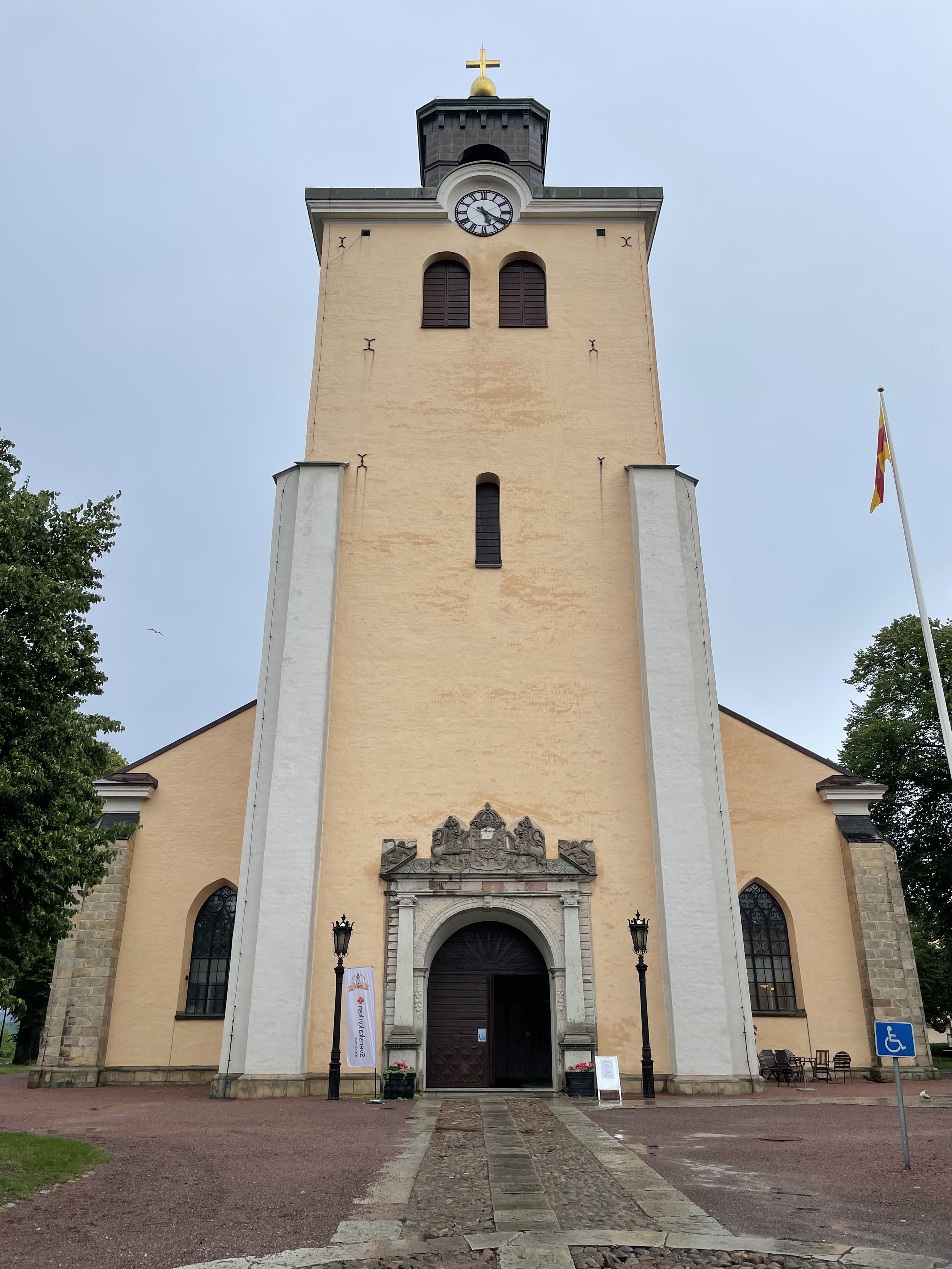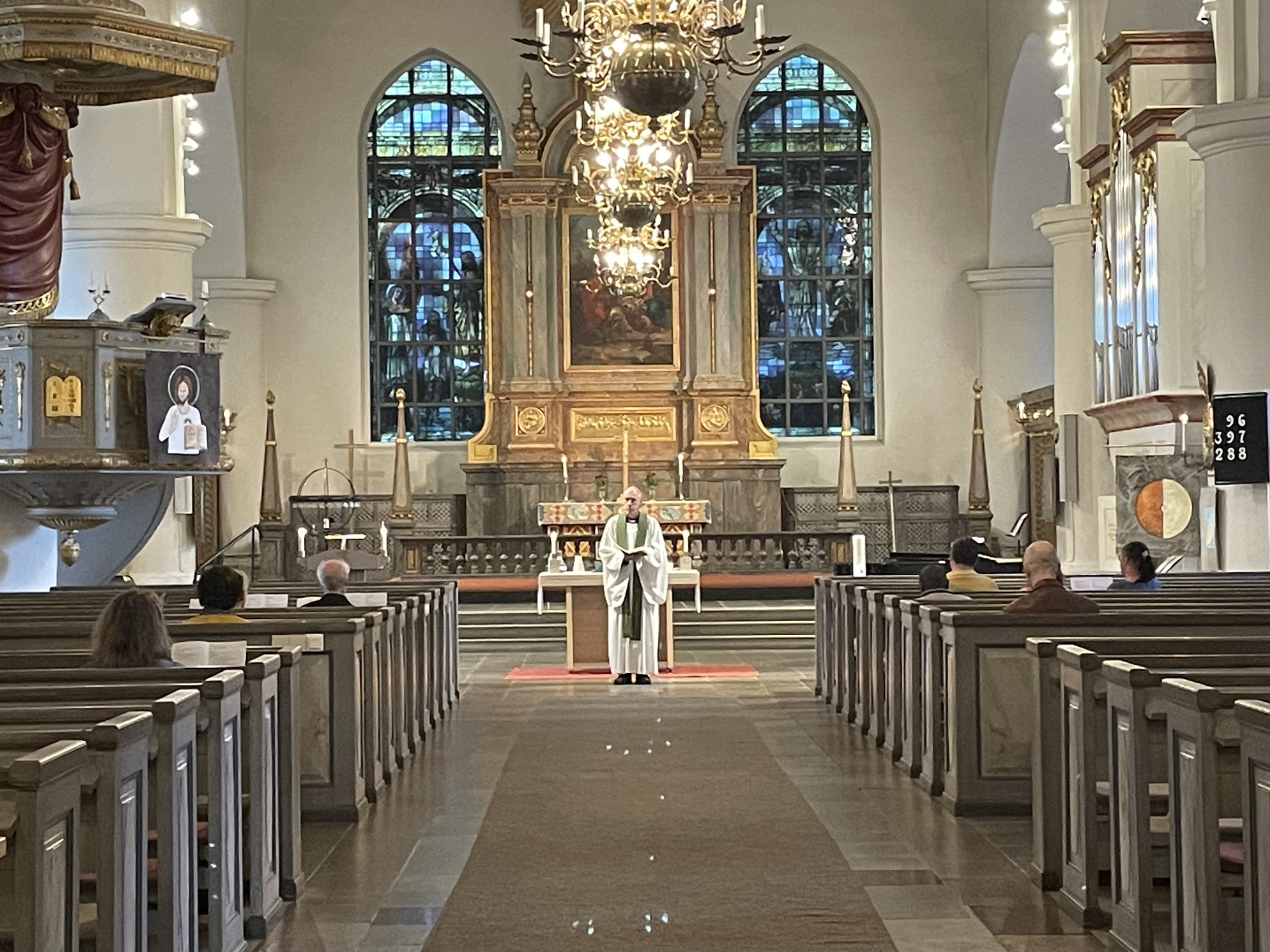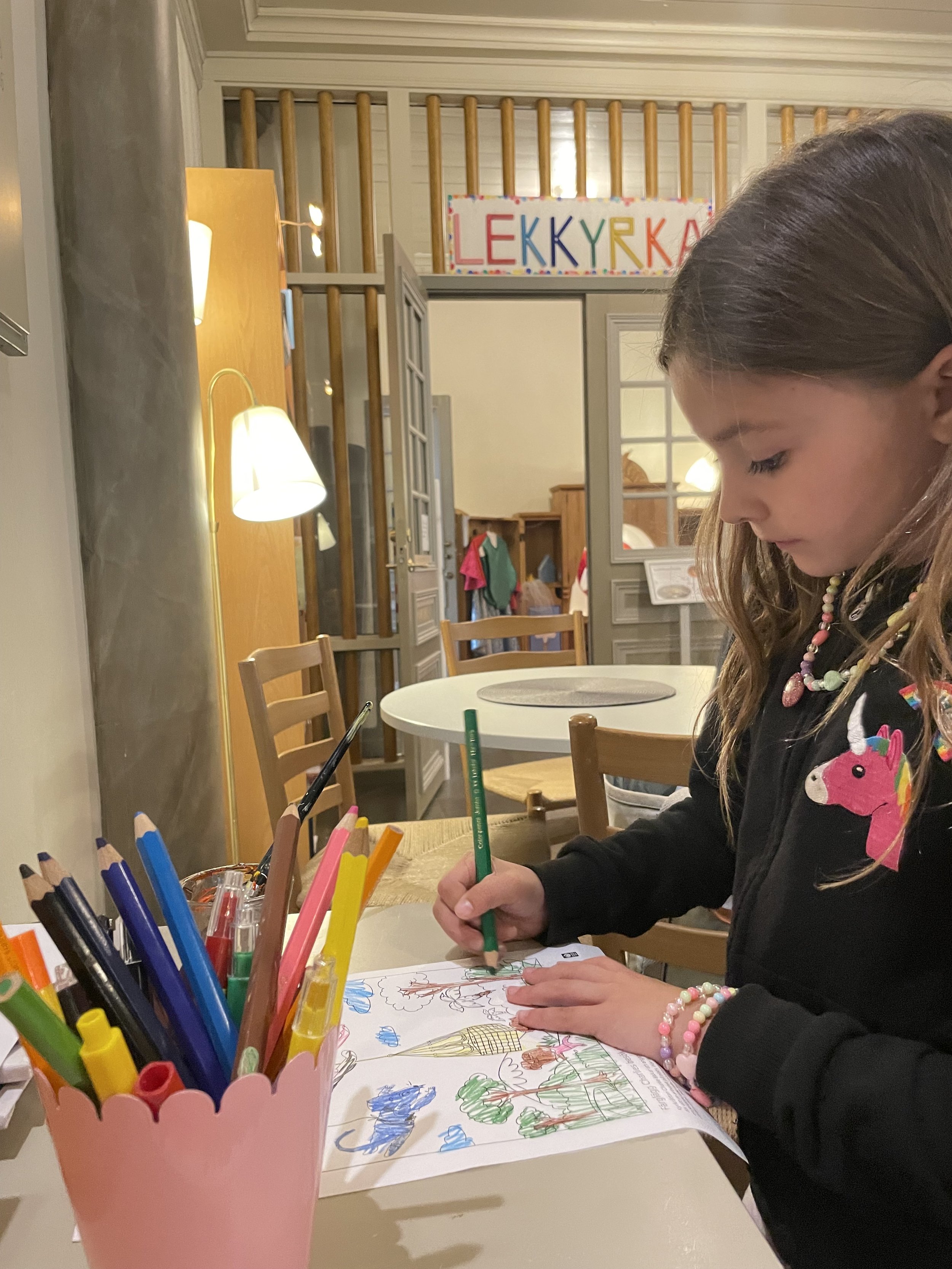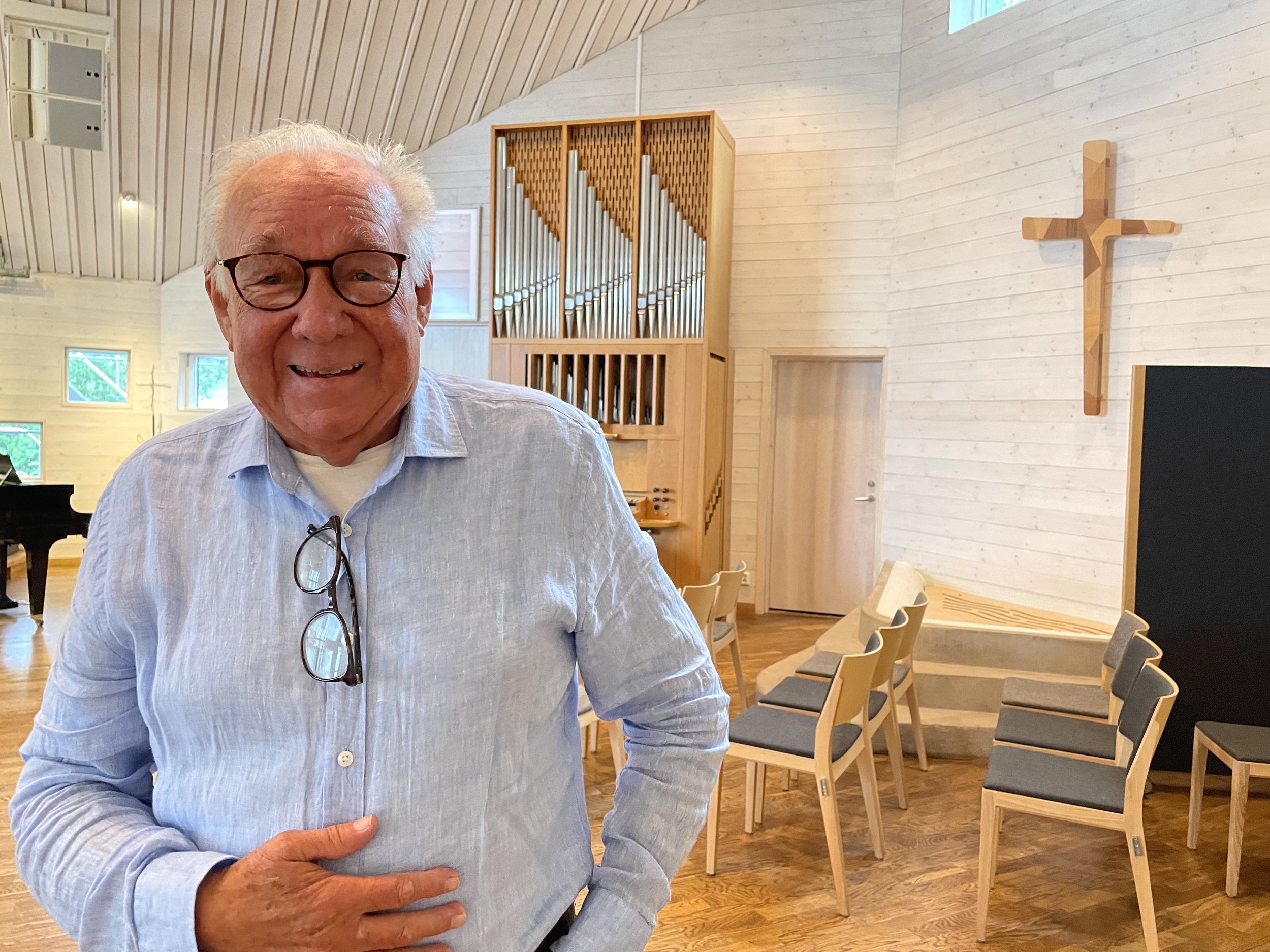Churches Flourish In One of Sweden’s Bible Button Cities By Caring For Neighbors
Jan-Anders Pettersson is a retired Pentecostal minister from Stockholm who now volunteers at the Pingst Jönköping church. (Photos by Paul Glader)
JÖNKÖPING, Sweden — Jan-Anders Pettersson struck a note of humility when describing attendance at Pingst Jönköping, a Pentecostal church in this downtown near the shore of Lake Vattern.
“Unfortunately, it is summer so we only have 1,200 or so in church on Sunday!” he said. Normally, 2,400 people might attend a worship service in the large sanctuary.
On this particular rainy Wednesday, Pettersson and his wife, Maud, were happily staffing the information booth in the foyer of the church while a group of 90 or so senior citizens enjoyed “fika,” or coffee, while hearing a local Lutheran pastor speak about “What is Happiness?” This senior group meets for coffee and intellectual stimulation once a week.
It’s a glimpse into the innovative methods Pingst Jönköping (“Pingst” means “Pentescostal”) and other “free churches” — mostly evangelical and charismatic churches — are using to grow members and outreach in their community, which is said to be one of the most religious areas in Sweden. It’s a sign that religion is far from dead in the traditionally Christian country, even though Sweden has seen a rise in secularism since the latter half of the 20th century. Do some of these flourishing “free churches” in Sweden offer lessons for counterparts in America and other places?
Pettersson rattled off myriad activities that happen at Pingst Jönköping between 8 a.m. and 9 p.m. throughout the week. For example, the church owns a café that’s open to the public and does a booming business in coffee, “kanelbullar” (cinnamon buns) and lunches on days when the city hosts a farmer’s market in the city parking lot adjacent to the church.
Other days, Pingst Jönköping hosts groups for moms and small children in its basement, which features a slide into a ball pit, a climbing wall, a puppet stage and a multisport gym area. A sign in the downstairs playground translates from the Swedish to, “Welcome to the playground. God loves you and promises to, at every time, be with you.”
My daughter, who questioned my desire to visit churches on a rainy weekday, came back from playing in the ball pit and said, “Dad! I should have never doubted you. This is amazing!”
“This is how we think church,” Pettersson said. “We need to meet people from their point of view. People and children need to be met.”
Pingst Jönköping offers Swedish language courses for immigrants from Ukraine, Syria and other places. It offers “Singoalla,” a ministry to help support single mothers financially and with babysitting. It has a separate “Kvinna”ministry for all women. The church has a radio station. It has a “Sjukhuskyrkan” (church hospital) program together with other churches to support hospital chaplains from multiple churches and faiths in the region. It has morning and evening prayer meetings and youth group on Fridays. The church also helps run a theological seminary with two other denominations across a range of six cities around Sweden.

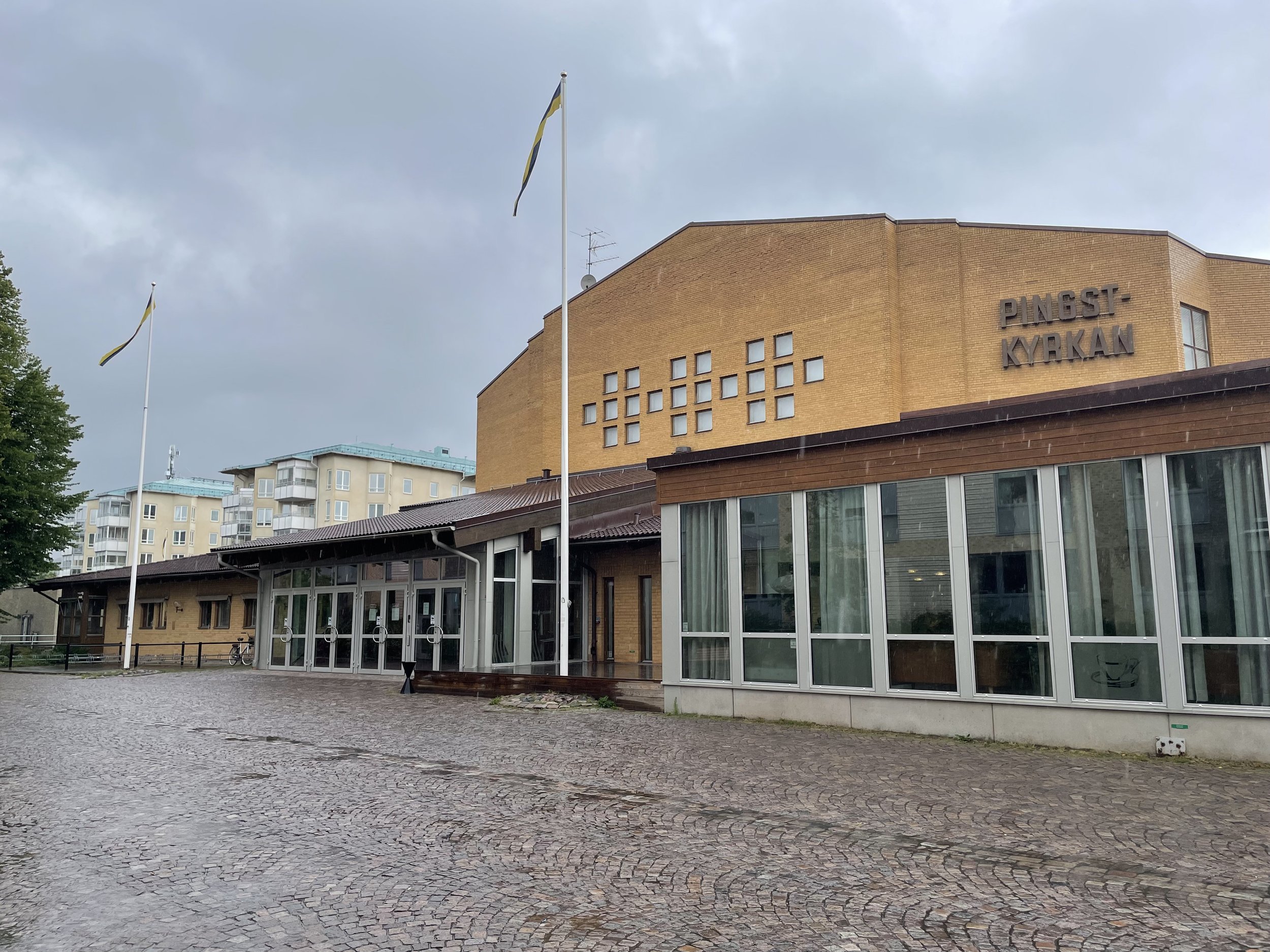
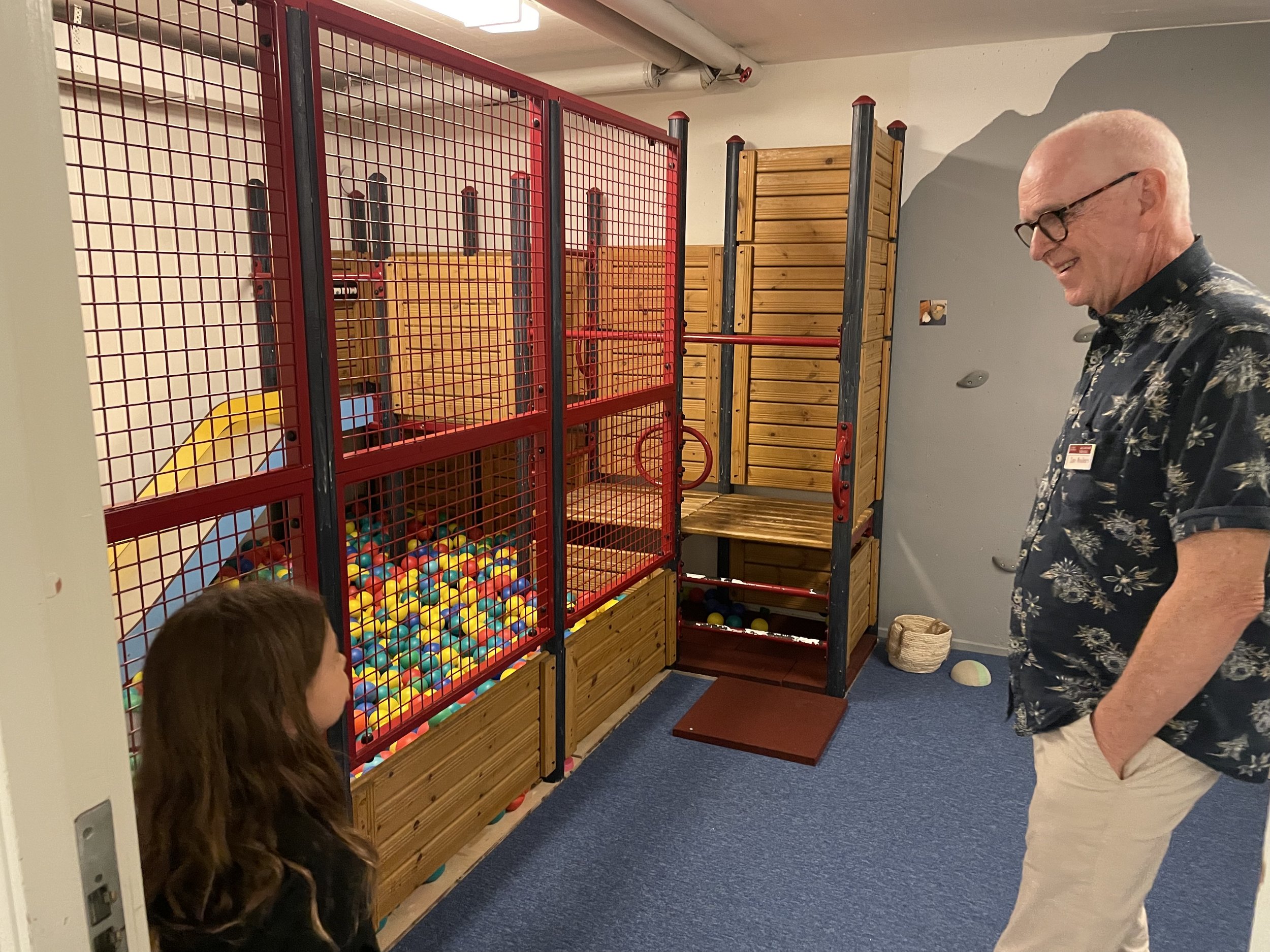
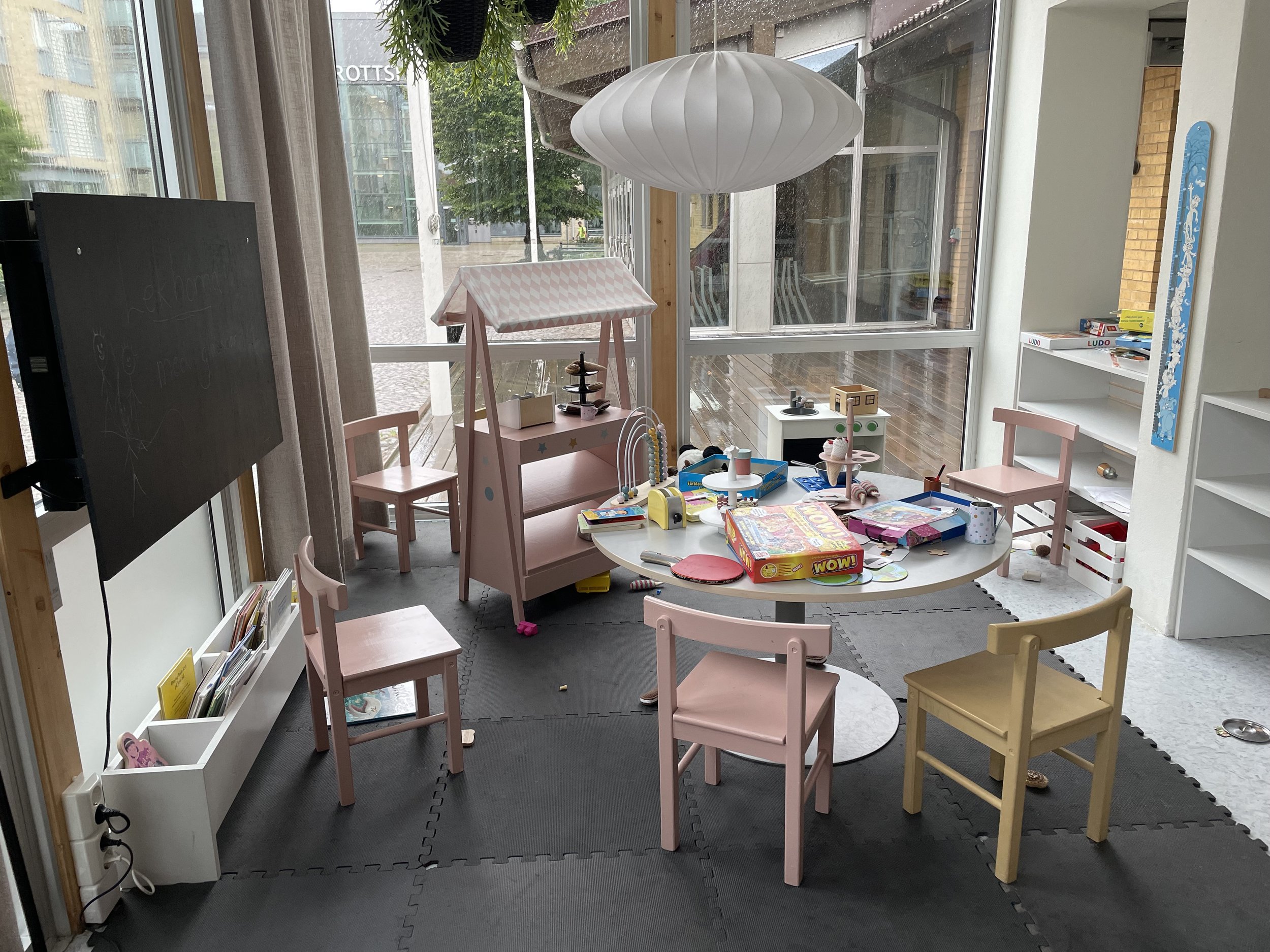
Oh. And did we mention missions?
“We have mission work around the world,” Pettersson said.
“Yes! Of course!” chimed in Maud Pettersson.
“We have been supporting work in Ethiopia by starting churches there,” Jan-Anders Pettersson said, noting Pingst has started a church in Ethiopia with 10,000 members. It supports churches in Armenia and other places as well.
A rise in secularism
In Sweden, most of the beautiful old white churches that dot the countryside in each major town and city are part of the official Church of Sweden (Svenska kyrkan). Those Lutheran churches are entrenched into Swedish culture and traditions of baptisms, weddings and funerals.
But Swedes are increasingly Christian in a loose cultural sense, with a cross on the nation’s flag and national soccer uniforms. Meanwhile, attendance at the former state churches is abysmally low, and membership is sliding fast. The Church of Sweden separated from the state on Jan. 1, 2000. Before then, every Swede was born into the Church of Sweden if one parent was a member. Some Swedes are now divorcing themselves from church registration in an effort to pay slightly lower taxes. Roughly 52.8% of all Swedish citizens, or 5.5 million people, are members of the Church of Sweden today, down from 82.9% in the year 2000.
Some free churches, however, may be showing the way toward growth: engagement with young families, seniors, neighbors and the world. The Church of Sweden hasn’t completely given up on this kind of engagement either.
“You will normally find some form of cafe and/or program for senior citizens, families, youths, and even immigrants (book talks or testimonies for older members of churches, homework help, Swedish language classes as some of examples) at different churches (not just free churches),” said Jacob Rudenstrand, assistant general secretary for the Swedish Evangelical Alliance in Stockholm. “Many free churches have a long history in various cities and are therefore often located close to the city center and try to use their building in a creative way.”
Inger Alestig, a reporter at Dagen (The Day) newspaper that covers Christianity in Sweden, agreed that it’s common for “free churches” to be located in a city center near restaurants and cafes. “Many churches are also engaged in helping refugees in different ways, for example with training in Swedish,” language Alestig wrote to me.
A contrast at the Church of Sweden
On my first day in Småland, a province in southern Sweden that’s similar in size to the nation of Belgium, I drove to a town west of Jönköping called Bottnaryd to visit a beautiful medieval Church of Sweden that dates back to 1335, with the most current iteration dating to 1693.
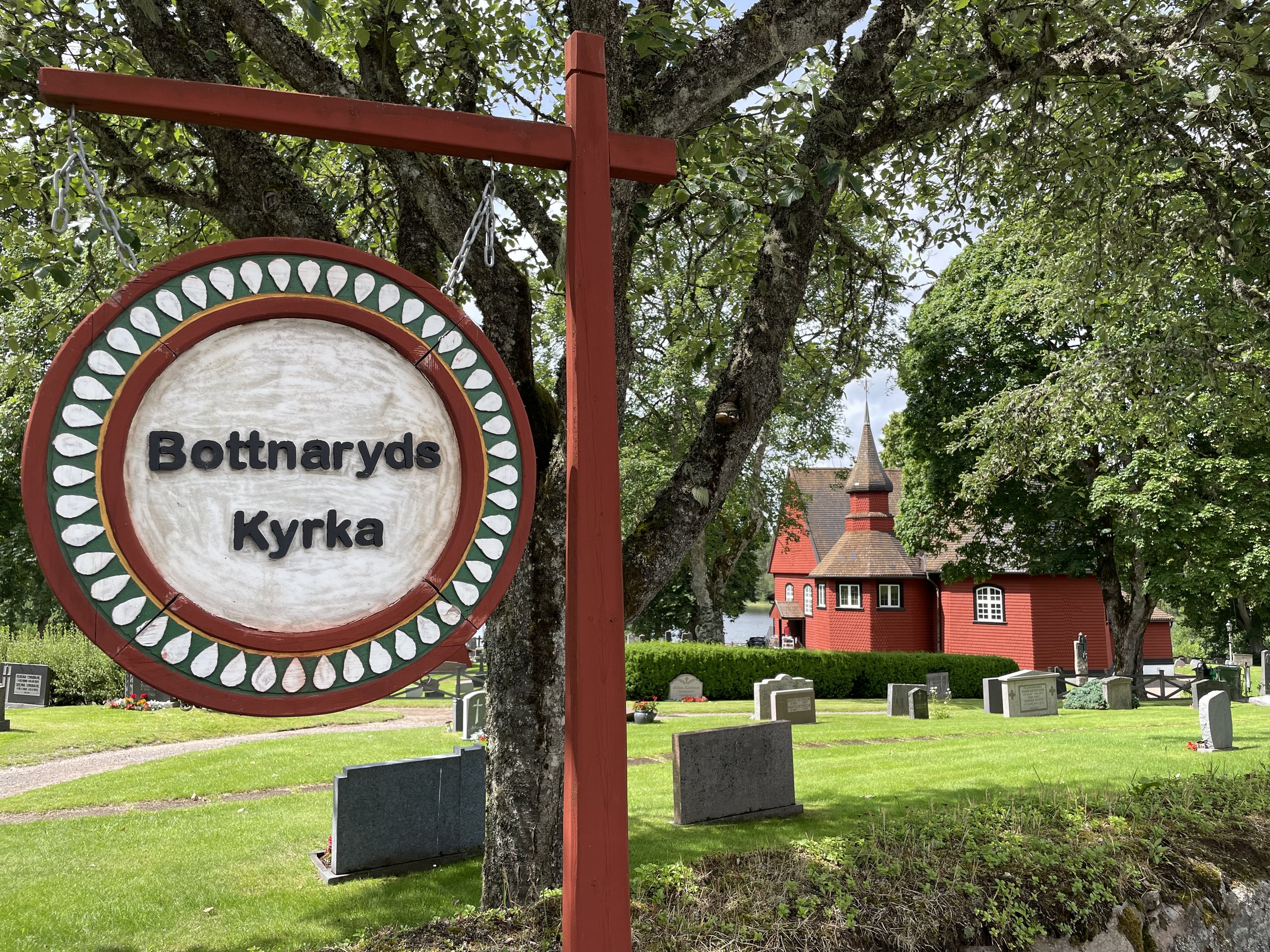
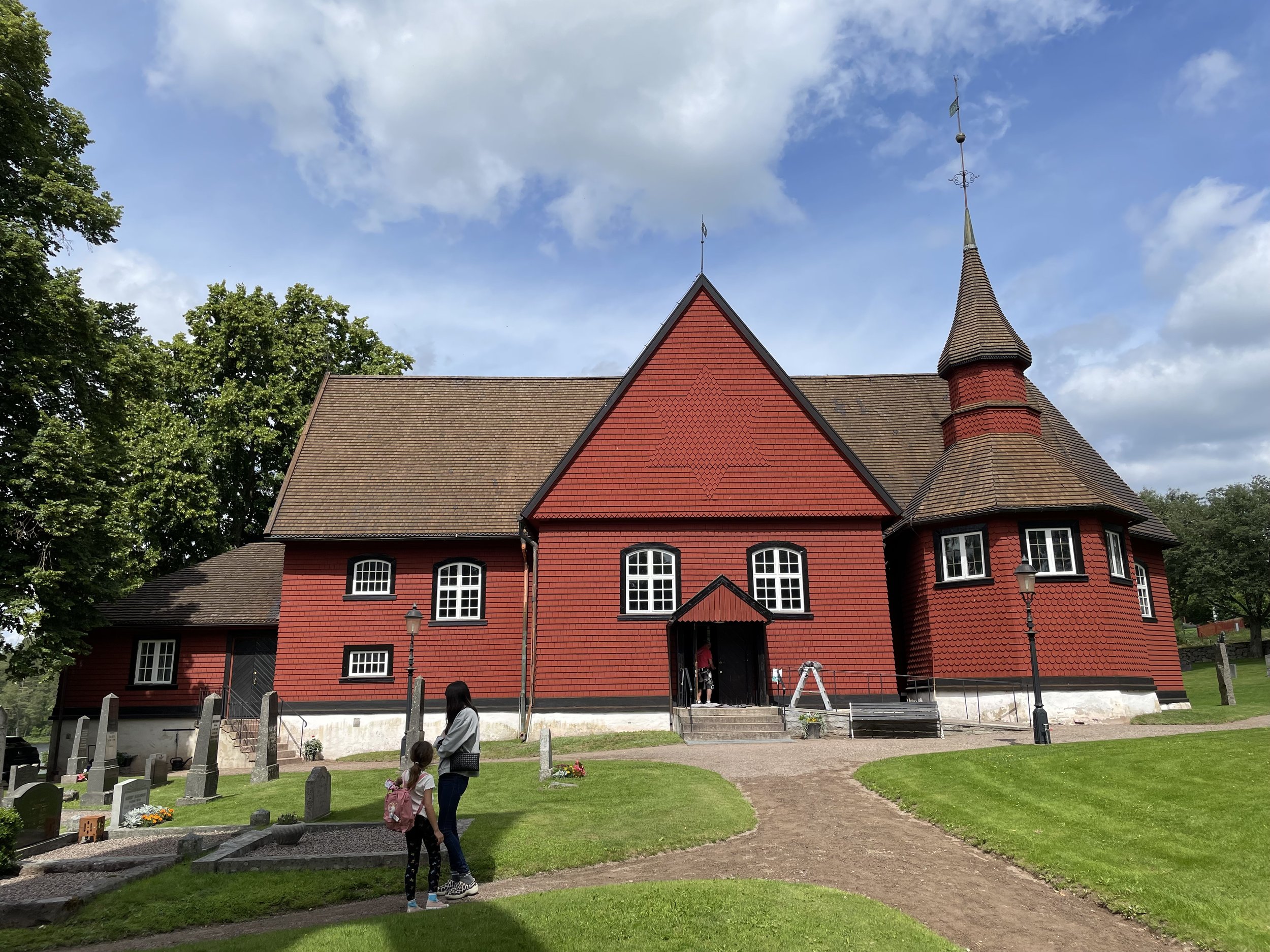
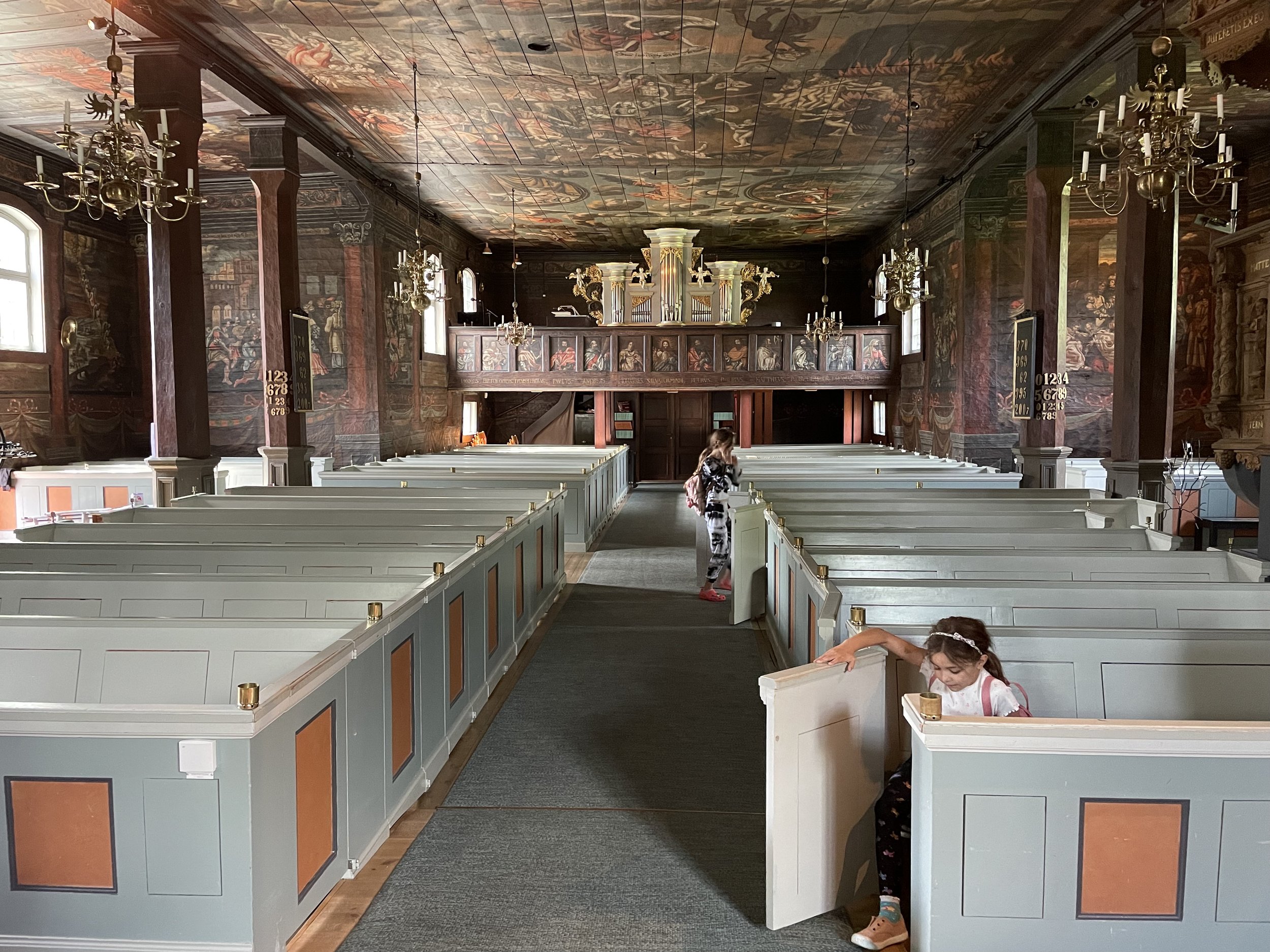
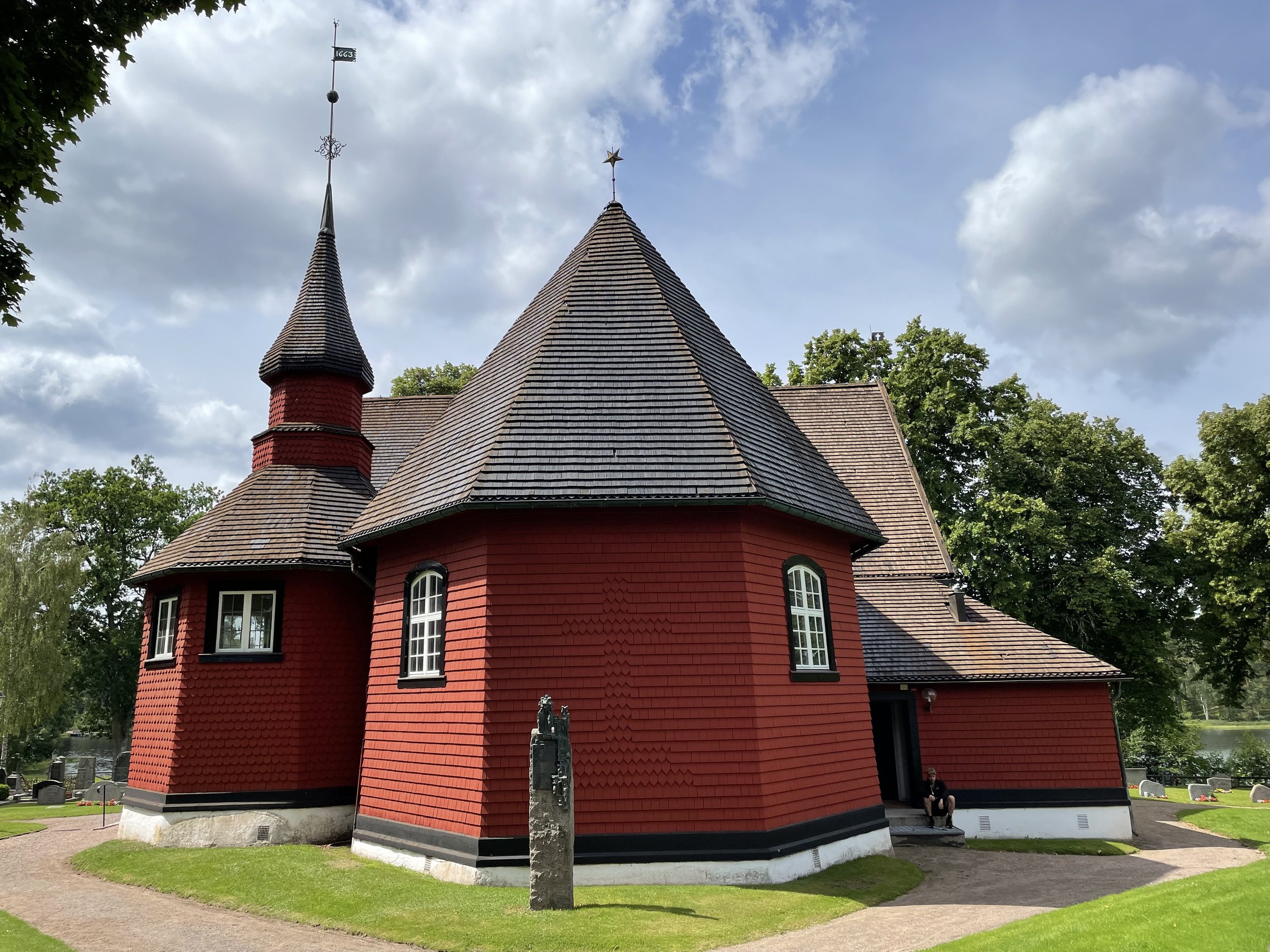
The wooden structure was painted red. It was surrounded by green space and the headstones of a cemetery. Workers wearing uniforms from the Church of Sweden were cleaning the cemetery, tidying up the church space and fixing furniture in the priest’s office. The interior of the sanctuary was adorned with dark wood and covered in murals that show the salvation of man from the beginning of creation until the ascension into heaven. While I admired the artwork in the sanctuary, my daughters explored play areas set up in the sanctuary.
Christina Brolin, a deacon in the Church of Sweden in Bottnaryd. (Photo by Paul Glader)
This particular parish is where a young man named Johan Printz grew up as the son of a priest. Printz received theological training himself before being shipped off to fight in the Thirty Years’ War in Germany and then becoming a governor of the Swedish colony in America on the Delaware River called “New Sweden” that lasted from 1638 to 1654. Printz returned to the region and served as governor, living in a nearby estate. His body is buried under the church, and a crypt features portraits of Printz and his wife as well as a coat of arms.
After admiring the church, I walked across the road to meet the parish priests. Christina Brolin, a deacon wearing a priest’s collar, greeted me warmly and introduced me to the priest, Bertil Johansson, who is preparing to retire soon.
“If only the old people come, we will die,” Johansson said. He noted seven or eight new people were confirmed at the church recently, which was a good sign.
“We are struggling a bit with the young families,” Brolin said, noting the church is “trying to get younger people into the church” with preschools one day a week for parents who are on maternity or paternity leave with young infants. She said only 20 people attend services each week. But up to 300 people attend jazz concerts at the church. They are hopeful a new, young organist might be able to start a successful children’s choir.
“People say Sweden is so secular and people don’t believe,” Brolin said. “But, in our society, everything is built on the Christian tradition. Deep down, most people pray. Most people turn to God. When someone dies or gets into difficulties, that’s the natural thing to do.”
I also made a visit in downtown Jönköping to the stunning main cathedral at Östra Storgatan 45, which was built in 1673 and is celebrating its 350th birthday this year. A church worker named Fredrik wore long hair and a handlebar mustache. He directed me to a kid’s playroom in the back of the church. He also pointed out some free tea and instant coffee for adults.
The children’s playroom had a sign over it that said “lekkyrka” and means “play church.” It featured priest costumes kids can wear, coloring books, some Lego bricks and dolls. Mass was starting in a few minutes, at 6 p.m., but Fredrik said kids can play all through the Mass.
As the Mass starts on a weekday night, I saw about 10 people spread throughout the pews that could hold perhaps 800 people. The priest’s tone was calm and, perhaps, even sedate. I could hear him say “Jesus” a number of times during his homily. As I looked around the foyer to the sanctuary, I saw C.S. Lewis books on a bookshelf.
Exploring the ‘Bible Button’
“This area is the Bible Belt,” Jan-Anders Pettersson at Pingst said. “We have a saying in Sweden that Jönköping is Småland’s Jerusalem. It is the Jerusalem of Småland.”
Several others in the United States and Sweden suggested that Jönköping was the “Jerusalem of Småland” and perhaps the center of the “Bible Belt” in Sweden because churches have a strong presence in the city. However, I learned that the more religious communities don’t stretch across Sweden the way they do in the American South. Rather, in Sweden, I’m told you find pockets of great religious attendance and practice, creating a set of “Bible buttons” that help hold together the fabric of religion. As I proposed the idea of “Bible Suspenders” or “Bible Buttons” instead of a “Bible Belt,” most people I spoke with seemed to enjoy the idea of “Bible Buttons.”
Although church attendance has dipped in Jönköping since 1992, it’s still seen as more religious. Rudenstrand explained that the “Jerusalem” reputation dates back to the later part of the 1800s, when the government stopped outlawing prayer gatherings and Bible studies in people’s homes. That meant the state church stopped regulating religious services and allowed people to meet outside the state church and without a Lutheran priest present. Revival meetings started happening in Småland, and Jönköping was the center of the quarterly revivals that would last for three days at a time.
“People took their cars if they had cars,” Pettersson said. “Or they would walk, take the train or ride horses. They went up to Jönköping. And they compared it to going up to Jerusalem, like a pilgrimage. There was a spiritual feast.”
Johannes Ottestig, a reporter at Dagen, told me that other cities such as Sävsjö, Vetlanda, Aneby, Vaggeryd, Gislaved, Smålandsstenar and Gnosjö are also known for strong church traditions.
“The spread of the Swedish Bible Belt is not only limited to Jönköping County, but with branches via Sjuhäradsbygden in southern Västergötland toward Gothenburg (Göteborg), and the Gothenburg archipelago has an offshoot to the west, south toward the Växjö area, toward Skåne’s Örkelljunga and Hässleholm,” Ottestig said. “To the east there is a spur toward Oskarshamn via Målilla as the only spur. The whole of Småland is often mistakenly assumed to be part of the Bible Belt. The free church movements spread with the railway, which explains the long spurs also into other regions and areas where surrounding parishes remained state church.” Pastors and Bible teachers traveled by trains, sharing the Christian message and planting free churches throughout the country along rail lines and train stops.
The journalist, Alestig, noted that hundreds of thousands of Swedes left Småland between 1850 and 1930 and emigrated to the United States, because of difficult farming conditions, poverty and starvation. “Småland used to be the poorest region of Sweden, and also – already during this time — a part of Sweden where free churches gained support,” Alestig said. Some of these emigrants spread Scandinavian-style Protestantism in the United States.
To make sure my perspective from Pingst church wasn’t ill-informed, I stopped by two other free churches that Alestig in Stockholm recommended. One was called Immanuelskyrkan, “Immanuel’s Church.” There, on a rainy Wednesday afternoon, I found a cafeteria full of dozens of people having food and coffee together and hearing about Christian work in the Republic of Congo (as I saw slides projected on the wall).
Immanuelskyrkan in Jonkoping, Sweden. (Photo by Paul Glader)
I also made a stop at Andreasförsamlingen Fjällstugan (at Sommarhemsgatan 7), which Inger described as “a sort of combination of church/ place for summer camps, with a nice view on the city and the lake.” She wasn’t kidding. The view from this church of the lake and downtown Jönköping was lovely. The cafe had just closed for the day. The pastor and several senior citizens were preparing for a midweek lecture by a woman who had exchanged letters for 50 years with the famous children’s book author Astrid Lindgren, author of the “Pippi Longstocking” series.
A kind older man named Nils Emme spoke with me about the church. He said it has 450 members with programs on Sunday mornings and evenings and on Wednesdays. Emme said he thinks only 2-3% of schoolchildren in Sweden attend the free churches. But in Jönköping, he thinks 10% of schoolchildren attend the free church. He thinks Jönköping is indeed a “Bible Button.”
“I think it was a poor part of Sweden 100 or 150 years ago. So I think the people were depending on God more,” Emme said. “It was very hard to run a farm in this area.”
Nils Emme at Andreasförsamlingen Fjällstugan in Jonkoping, Sweden. (Photo by Paul Glader)
Outside these “Bible Buttons,” Dagen reports that Muslim communities are growing quickly while traditional free churches are shrinking such as the Equmenia Church, which lost 3,930 members since 2017 for a total membership of 58,569 in 2021. The Evangelical Free Church decreased slightly by 1,654 members since 2017 for a 2021 total of 27,582 members. The Pentecostal movement churches only lost 546 members since 2017, with 86,807 total members remaining in 2021. The churches growing most rapidly in Sweden are actually the Catholic Church, followed by the Orthodox Christian Church.
“The understanding of religion is a little bit going down,” said Pettersson, the retired Pentecostal minister from Stockholm who now volunteers at Pingst Jönköping. “The younger generations don’t understand it so much.” He sees more charismatic efforts such as Hillsong Church reaching younger people. “We are baptizing many people. But Sweden has similar trends to the United States,” Pettersson said. “It’s a struggle.”
The United Islamic Societies nearly doubled from less than 15,000 members in 2017 to 30,000 members in 2021 and has a Sunni mosque in Stockholm’s Södermalm area. Another Sunni Muslim community called the Islamic Cultural Union in Sweden grew from 10,755 members in 2017 to 18,557 members in 2021 according to Dagen research. The Islamic Shia Communities has grown to 36,774 members in 2021.
Meanwhile, the Catholic Church gained 7,285 members since 2017, with 126,286 total members in Sweden. The Macedonian Orthodox, Syriac Orthodox and Romanian Orthodox churches all grew to total 32,455 members. By contrast, the Church of Sweden had roughly 5.6 million members in 2021 but lost 365,301 members since 2017.
Free churches and nationalism?
I was curious how the free churches align politically and if they compare to the U.S., where Protestant evangelicals tend to vote Republican, with a large majority voting for Donald Trump in 2016 and 2020. Do Swedish evangelicals also lean right politically on issues such as abortion and immigration? Would many of them characterize themselves as “Christian nationalists?”
Alestig noted that Sweden has a range of political parties, which creates a richer mosaic rather than a political binary. At times, free churches aligned more with the Social Democratic Party, particularly on issues such as trade unions, supporting the poor, caring for the elderly and helping single mothers.
As Social Democrats became more hostile to religion and believers cared more about social issues, some new parties emerged, such as Folkpartiet (Liberals) and Kristdemokraterna (Christian Democrats). Alestig said her newspaper has reported data that most members of the Church of Sweden vote left for the Social Democrats, Vansterpartiet or the Green Party. She believes most free church attendees vote to the right, meaning Christian Democrats, Liberals or Moderaterna.
Alestig thinks few churchgoers in Sweden would vote for newer populist parties, such as Sverigedemocraterna, which take on Christian nationalist rhetoric and imagery. But she sees Sverigedemocraterna trying to recruit evangelical voters and perhaps winning a few of them on culture war issues such as abortion, stronger national defense and limited immigration.
“I don’t think the term ‘Christian nationalist’ would mean very much to people in Sweden,” Alestig said. “To be Christian is not linked to being a nationalist. In this regard Sweden differs from the U.S.”
Rudenstrand said that linking conversations and sermons that mention the golden cross on the Swedish flag, the nation’s Christian heritage and a sense of a “calling to the nations” to the idea of “Christian nationalism” is “not near some of the extreme forms in the U.S.”
“Most evangelical Christians in Sweden are pro-migrants even if the preferred level of immigration varies among Christians in Sweden,” Rudenstrand said. “This is due to the fact that issues such as segregation, crime, and other related issues are at the forefront of the political debate today. Some Christians to the left would describe the political movement today in nationalistic terms, and there are recurring debates about whether the government’s policies are Christian or not.”
Rudenstrand said that many bishops in the Lutheran Church of Sweden lean more left and criticize the government policies on migration for being “too conservative / nationalistic and not Christian enough based on Leviticus chapter 19.” So he sees some Church of Sweden leaders view Sweden as having a divine calling but from the “other side of the political spectrum.”
Finding solutions in the Greatest Commandment
Rudenstrand said some of the cultural elite in Sweden speak and write about the importance of faith and the church for them, but he still sees secularism as the norm in education, politics and culture in Sweden. He thinks Protestant evangelicals are still often viewed with suspicion for their beliefs in the reliability of the Bible, the bodily resurrection of Jesus and questions of truth.
“Many of us evangelicals outside the U.S. are mostly a minority of the population compared to our brothers and sisters in the U.S. and thus lack any real cultural and political influence,” Rudenstrand said. “Because of this we have learned and continue to learn how to live creatively for the gospel in a very secularized country, something the U.S. is moving toward.”
Jan-Anders and Maud Pettersson at Pingst Jönköping pentecostal church. (Photo by Paul Glader)
Journalists Ottestig and Alestig said that it’s quite normal for churches to have cafes open to the public and located in city centers where people pass by. They don’t see those offerings as particularly innovative. They noted that, just like in America, when free churches close in central urban areas, their buildings are sometimes turned into hotels or homes. Alestig said some churches are also merging in parts of Sweden.
In rural parts of Sweden, Alestig said that schools and shops might close but the local church often remains and “becomes the place where people can meet.” And in those parts of Sweden, “the church and the priest are central to peoples’ well-being, and so it becomes relevant in the life of society.”
Alestig said she finds Protestants waking up at 5 a.m. to serve breakfast at their churches to immigrants from Syria during the wave of refugees coming to Sweden in 2015 and 2016. She said Christians in Sweden opened their houses for Ukraine refugees after Russia invaded Ukraine.
“I think there is a great tradition in Sweden to link social care to the love of God,” Inger said.
Jan-Anders and Maud moved to Jönköping three years ago from Stockholm, where he pastored pentecostal churches for 25 years, because some of their kids and grandchildren live in Jönköping.
They felt they could enjoy being part of a church community that is living out the great commandment to “Love the Lord your God with all your heart and to love your neighbor as yourself.”
“We love to be here,” Maud said. “This church is so open every day.”
Helping neighbors is key in their view. “I think that’s a way to reach out the hand and grow together,” Jan-Anders said. “It shows our faith helps us with our ordinary lives.”
The Petterssons volunteer to scrub toilets and clean the Pingst Jönköping church and to work the front desk some days. Other days, they enjoy meeting immigrants in their neighborhood and having coffee chats with some of them using Google translate.
“The doctrines are important,” Jan-Anders Pettersson said. “The love and life in Jesus is more important.”
Paul Glader is executive editor of ReligionUnplugged.com and executive director of The Media Project. He has reported from dozens of countries for outlets ranging from The Wall Street Journal, The Washington Post, Der Spiegel Online and others. He’s on Twitter @PaulGlader



